Critical Analysis of Medication Error Research: NSG2NMR Assessment 2
VerifiedAdded on 2022/09/18
|11
|2848
|15
Report
AI Summary
This report critically analyzes two research papers focusing on medication administration errors. The first study, a quantitative study, investigated interventions to reduce drug preparation errors in a tertiary care center, examining the impact of electronic databases, e-learning guides, print information, and teaching sessions. The study found that these interventions significantly reduced errors in preparing drugs for tube administration and improved adherence to safety measures. The second study, a qualitative study, explored registered nurses' perceptions of challenges in the medication administration process through focus group interviews. The study identified challenges related to medications, skills, education, patient-related factors, and collaboration. The report compares and contrasts the aims, methods, results, and validity of each study, discussing their contributions to understanding and mitigating medication errors and improving patient safety. Both studies highlight the need for comprehensive interventions, including improved training, standardized procedures, and enhanced communication, to address the ongoing challenges in medication administration.
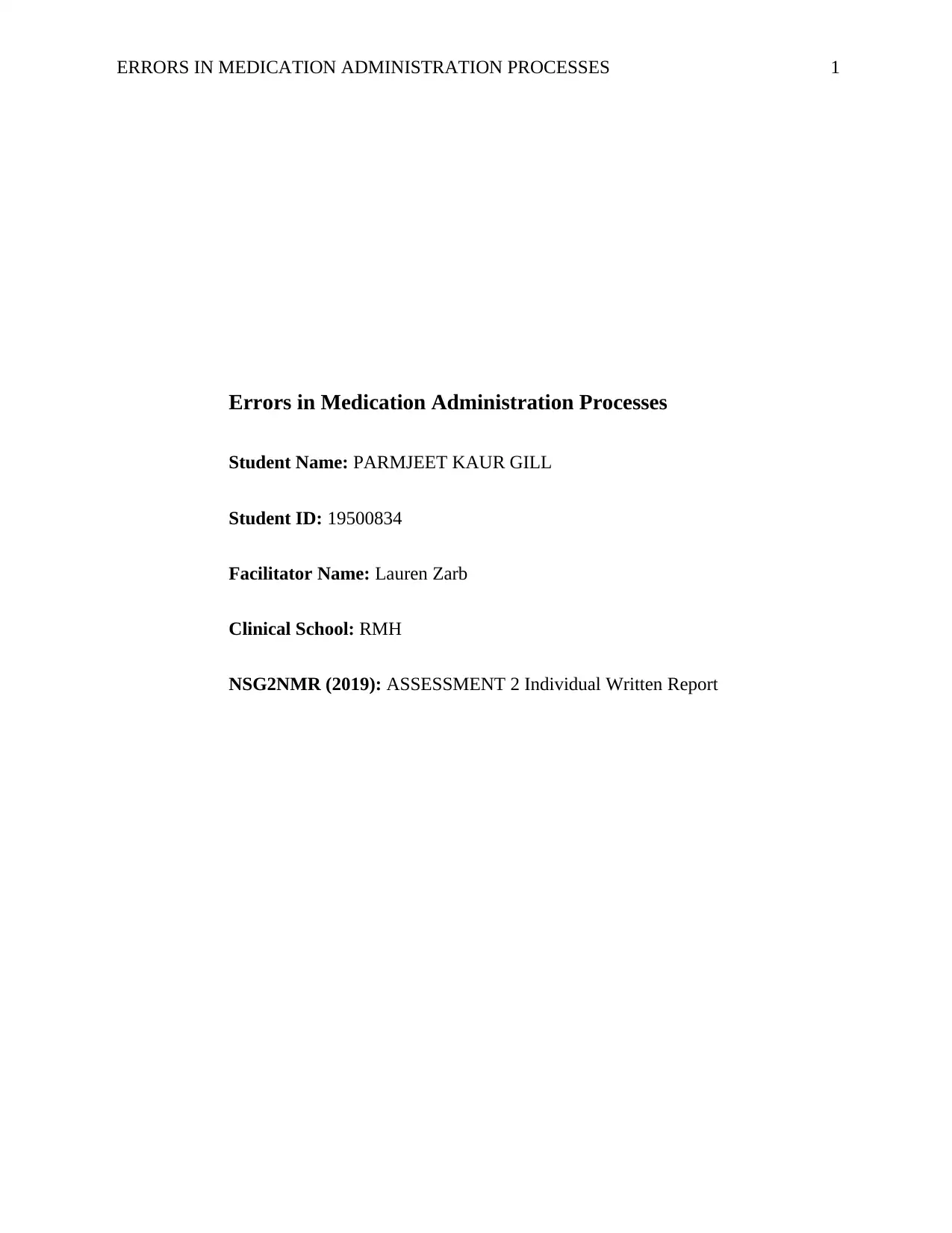
ERRORS IN MEDICATION ADMINISTRATION PROCESSES 1
Errors in Medication Administration Processes
Student Name: PARMJEET KAUR GILL
Student ID: 19500834
Facilitator Name: Lauren Zarb
Clinical School: RMH
NSG2NMR (2019): ASSESSMENT 2 Individual Written Report
Errors in Medication Administration Processes
Student Name: PARMJEET KAUR GILL
Student ID: 19500834
Facilitator Name: Lauren Zarb
Clinical School: RMH
NSG2NMR (2019): ASSESSMENT 2 Individual Written Report
Paraphrase This Document
Need a fresh take? Get an instant paraphrase of this document with our AI Paraphraser
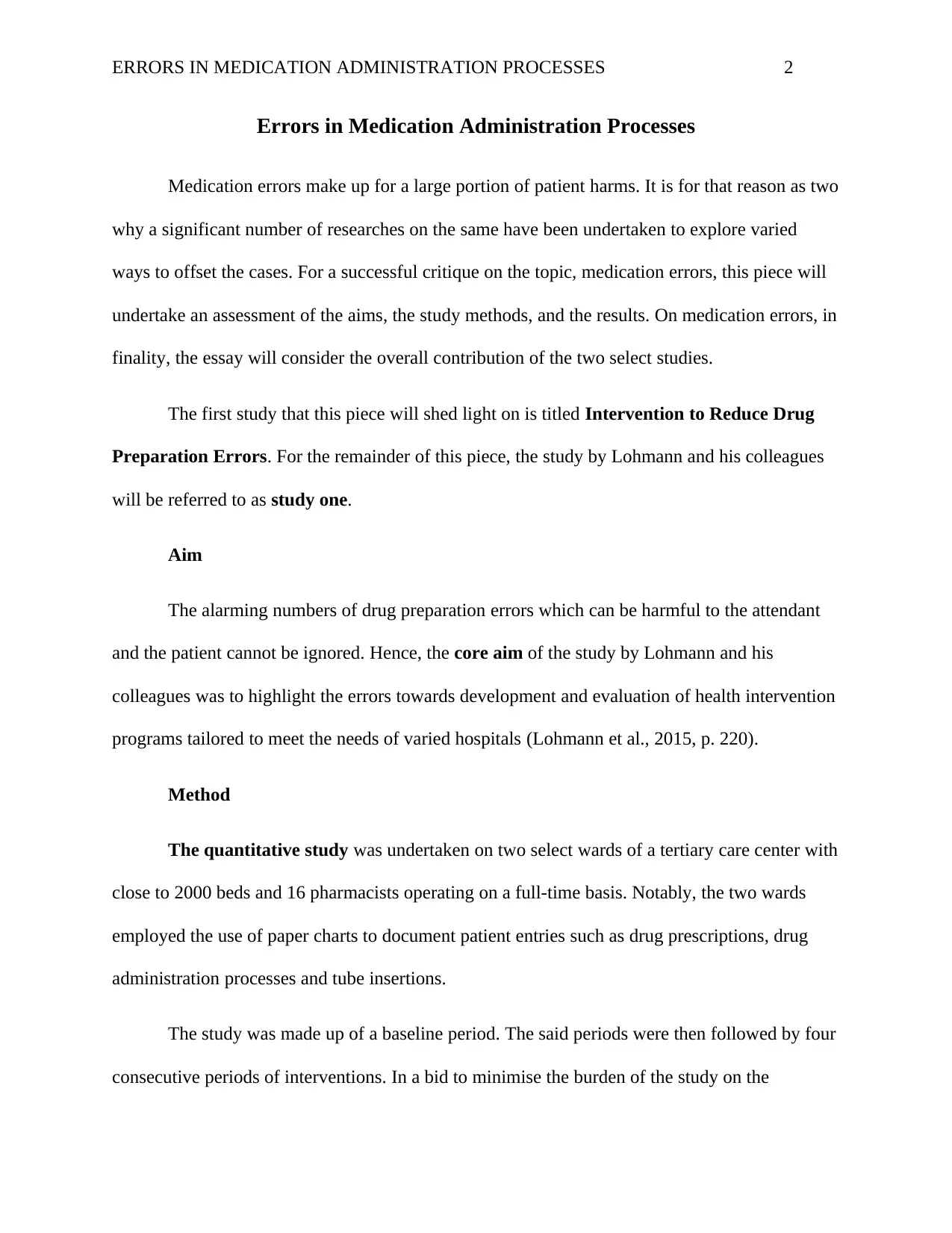
ERRORS IN MEDICATION ADMINISTRATION PROCESSES 2
Errors in Medication Administration Processes
Medication errors make up for a large portion of patient harms. It is for that reason as two
why a significant number of researches on the same have been undertaken to explore varied
ways to offset the cases. For a successful critique on the topic, medication errors, this piece will
undertake an assessment of the aims, the study methods, and the results. On medication errors, in
finality, the essay will consider the overall contribution of the two select studies.
The first study that this piece will shed light on is titled Intervention to Reduce Drug
Preparation Errors. For the remainder of this piece, the study by Lohmann and his colleagues
will be referred to as study one.
Aim
The alarming numbers of drug preparation errors which can be harmful to the attendant
and the patient cannot be ignored. Hence, the core aim of the study by Lohmann and his
colleagues was to highlight the errors towards development and evaluation of health intervention
programs tailored to meet the needs of varied hospitals (Lohmann et al., 2015, p. 220).
Method
The quantitative study was undertaken on two select wards of a tertiary care center with
close to 2000 beds and 16 pharmacists operating on a full-time basis. Notably, the two wards
employed the use of paper charts to document patient entries such as drug prescriptions, drug
administration processes and tube insertions.
The study was made up of a baseline period. The said periods were then followed by four
consecutive periods of interventions. In a bid to minimise the burden of the study on the
Errors in Medication Administration Processes
Medication errors make up for a large portion of patient harms. It is for that reason as two
why a significant number of researches on the same have been undertaken to explore varied
ways to offset the cases. For a successful critique on the topic, medication errors, this piece will
undertake an assessment of the aims, the study methods, and the results. On medication errors, in
finality, the essay will consider the overall contribution of the two select studies.
The first study that this piece will shed light on is titled Intervention to Reduce Drug
Preparation Errors. For the remainder of this piece, the study by Lohmann and his colleagues
will be referred to as study one.
Aim
The alarming numbers of drug preparation errors which can be harmful to the attendant
and the patient cannot be ignored. Hence, the core aim of the study by Lohmann and his
colleagues was to highlight the errors towards development and evaluation of health intervention
programs tailored to meet the needs of varied hospitals (Lohmann et al., 2015, p. 220).
Method
The quantitative study was undertaken on two select wards of a tertiary care center with
close to 2000 beds and 16 pharmacists operating on a full-time basis. Notably, the two wards
employed the use of paper charts to document patient entries such as drug prescriptions, drug
administration processes and tube insertions.
The study was made up of a baseline period. The said periods were then followed by four
consecutive periods of interventions. In a bid to minimise the burden of the study on the
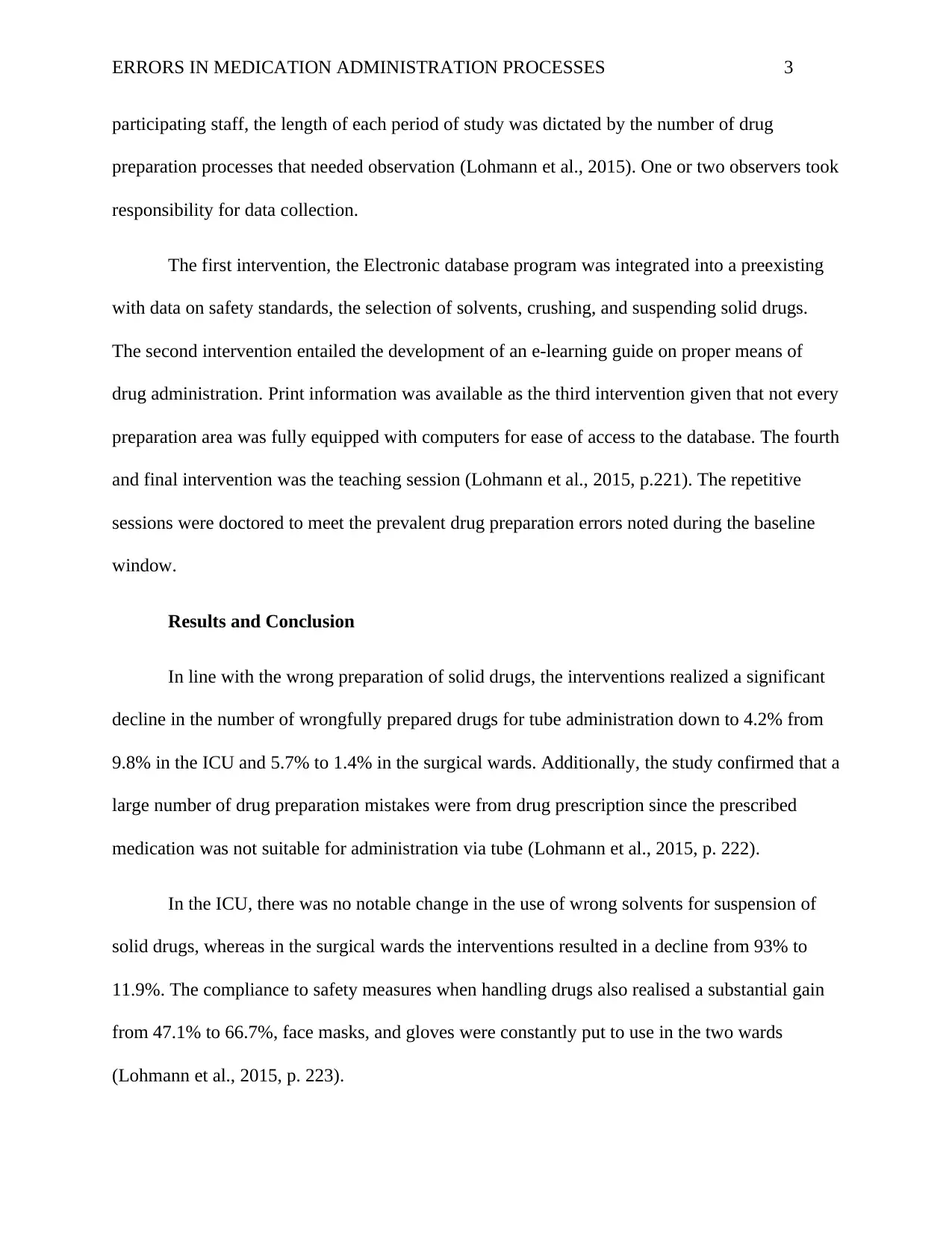
ERRORS IN MEDICATION ADMINISTRATION PROCESSES 3
participating staff, the length of each period of study was dictated by the number of drug
preparation processes that needed observation (Lohmann et al., 2015). One or two observers took
responsibility for data collection.
The first intervention, the Electronic database program was integrated into a preexisting
with data on safety standards, the selection of solvents, crushing, and suspending solid drugs.
The second intervention entailed the development of an e-learning guide on proper means of
drug administration. Print information was available as the third intervention given that not every
preparation area was fully equipped with computers for ease of access to the database. The fourth
and final intervention was the teaching session (Lohmann et al., 2015, p.221). The repetitive
sessions were doctored to meet the prevalent drug preparation errors noted during the baseline
window.
Results and Conclusion
In line with the wrong preparation of solid drugs, the interventions realized a significant
decline in the number of wrongfully prepared drugs for tube administration down to 4.2% from
9.8% in the ICU and 5.7% to 1.4% in the surgical wards. Additionally, the study confirmed that a
large number of drug preparation mistakes were from drug prescription since the prescribed
medication was not suitable for administration via tube (Lohmann et al., 2015, p. 222).
In the ICU, there was no notable change in the use of wrong solvents for suspension of
solid drugs, whereas in the surgical wards the interventions resulted in a decline from 93% to
11.9%. The compliance to safety measures when handling drugs also realised a substantial gain
from 47.1% to 66.7%, face masks, and gloves were constantly put to use in the two wards
(Lohmann et al., 2015, p. 223).
participating staff, the length of each period of study was dictated by the number of drug
preparation processes that needed observation (Lohmann et al., 2015). One or two observers took
responsibility for data collection.
The first intervention, the Electronic database program was integrated into a preexisting
with data on safety standards, the selection of solvents, crushing, and suspending solid drugs.
The second intervention entailed the development of an e-learning guide on proper means of
drug administration. Print information was available as the third intervention given that not every
preparation area was fully equipped with computers for ease of access to the database. The fourth
and final intervention was the teaching session (Lohmann et al., 2015, p.221). The repetitive
sessions were doctored to meet the prevalent drug preparation errors noted during the baseline
window.
Results and Conclusion
In line with the wrong preparation of solid drugs, the interventions realized a significant
decline in the number of wrongfully prepared drugs for tube administration down to 4.2% from
9.8% in the ICU and 5.7% to 1.4% in the surgical wards. Additionally, the study confirmed that a
large number of drug preparation mistakes were from drug prescription since the prescribed
medication was not suitable for administration via tube (Lohmann et al., 2015, p. 222).
In the ICU, there was no notable change in the use of wrong solvents for suspension of
solid drugs, whereas in the surgical wards the interventions resulted in a decline from 93% to
11.9%. The compliance to safety measures when handling drugs also realised a substantial gain
from 47.1% to 66.7%, face masks, and gloves were constantly put to use in the two wards
(Lohmann et al., 2015, p. 223).
⊘ This is a preview!⊘
Do you want full access?
Subscribe today to unlock all pages.

Trusted by 1+ million students worldwide
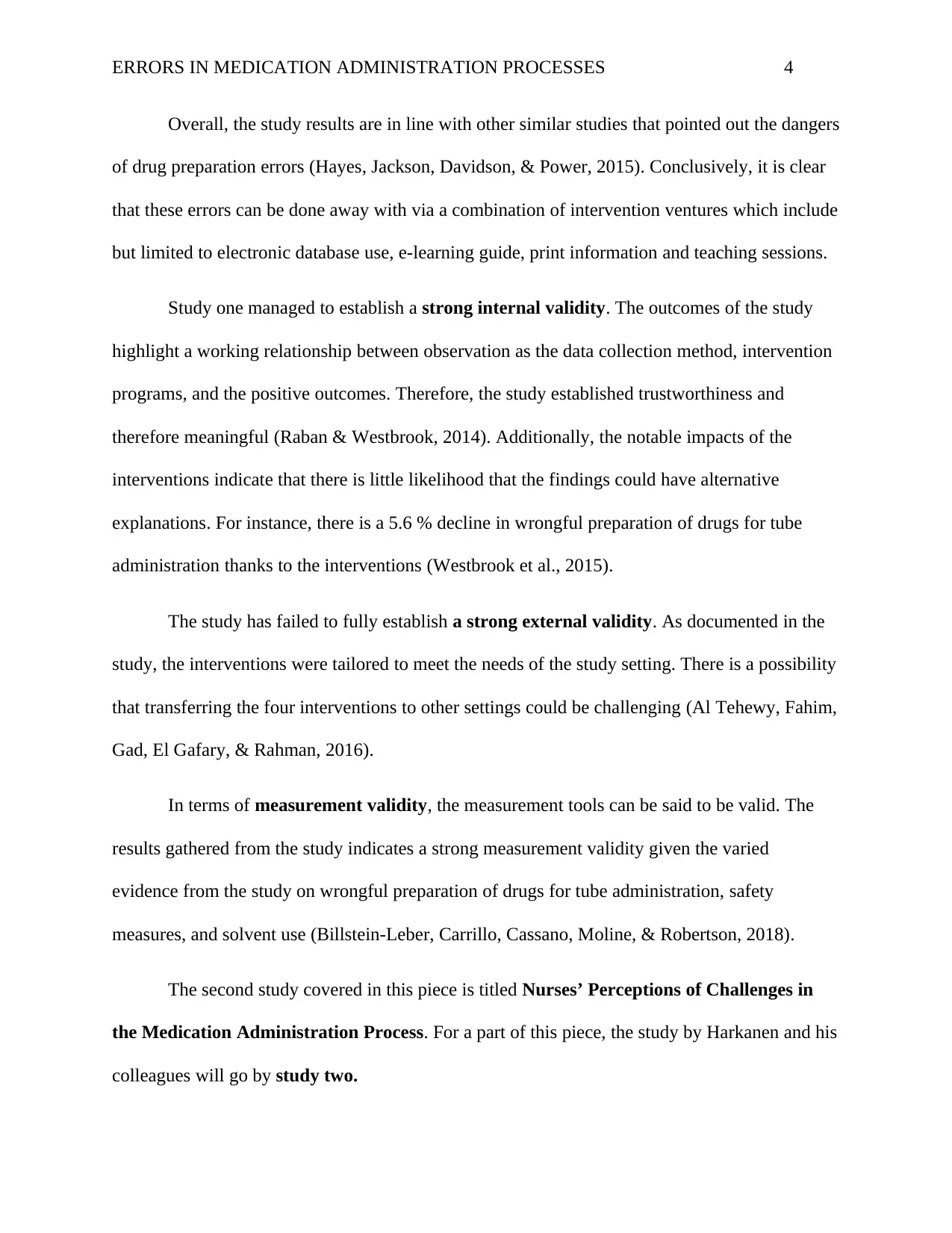
ERRORS IN MEDICATION ADMINISTRATION PROCESSES 4
Overall, the study results are in line with other similar studies that pointed out the dangers
of drug preparation errors (Hayes, Jackson, Davidson, & Power, 2015). Conclusively, it is clear
that these errors can be done away with via a combination of intervention ventures which include
but limited to electronic database use, e-learning guide, print information and teaching sessions.
Study one managed to establish a strong internal validity. The outcomes of the study
highlight a working relationship between observation as the data collection method, intervention
programs, and the positive outcomes. Therefore, the study established trustworthiness and
therefore meaningful (Raban & Westbrook, 2014). Additionally, the notable impacts of the
interventions indicate that there is little likelihood that the findings could have alternative
explanations. For instance, there is a 5.6 % decline in wrongful preparation of drugs for tube
administration thanks to the interventions (Westbrook et al., 2015).
The study has failed to fully establish a strong external validity. As documented in the
study, the interventions were tailored to meet the needs of the study setting. There is a possibility
that transferring the four interventions to other settings could be challenging (Al Tehewy, Fahim,
Gad, El Gafary, & Rahman, 2016).
In terms of measurement validity, the measurement tools can be said to be valid. The
results gathered from the study indicates a strong measurement validity given the varied
evidence from the study on wrongful preparation of drugs for tube administration, safety
measures, and solvent use (Billstein-Leber, Carrillo, Cassano, Moline, & Robertson, 2018).
The second study covered in this piece is titled Nurses’ Perceptions of Challenges in
the Medication Administration Process. For a part of this piece, the study by Harkanen and his
colleagues will go by study two.
Overall, the study results are in line with other similar studies that pointed out the dangers
of drug preparation errors (Hayes, Jackson, Davidson, & Power, 2015). Conclusively, it is clear
that these errors can be done away with via a combination of intervention ventures which include
but limited to electronic database use, e-learning guide, print information and teaching sessions.
Study one managed to establish a strong internal validity. The outcomes of the study
highlight a working relationship between observation as the data collection method, intervention
programs, and the positive outcomes. Therefore, the study established trustworthiness and
therefore meaningful (Raban & Westbrook, 2014). Additionally, the notable impacts of the
interventions indicate that there is little likelihood that the findings could have alternative
explanations. For instance, there is a 5.6 % decline in wrongful preparation of drugs for tube
administration thanks to the interventions (Westbrook et al., 2015).
The study has failed to fully establish a strong external validity. As documented in the
study, the interventions were tailored to meet the needs of the study setting. There is a possibility
that transferring the four interventions to other settings could be challenging (Al Tehewy, Fahim,
Gad, El Gafary, & Rahman, 2016).
In terms of measurement validity, the measurement tools can be said to be valid. The
results gathered from the study indicates a strong measurement validity given the varied
evidence from the study on wrongful preparation of drugs for tube administration, safety
measures, and solvent use (Billstein-Leber, Carrillo, Cassano, Moline, & Robertson, 2018).
The second study covered in this piece is titled Nurses’ Perceptions of Challenges in
the Medication Administration Process. For a part of this piece, the study by Harkanen and his
colleagues will go by study two.
Paraphrase This Document
Need a fresh take? Get an instant paraphrase of this document with our AI Paraphraser
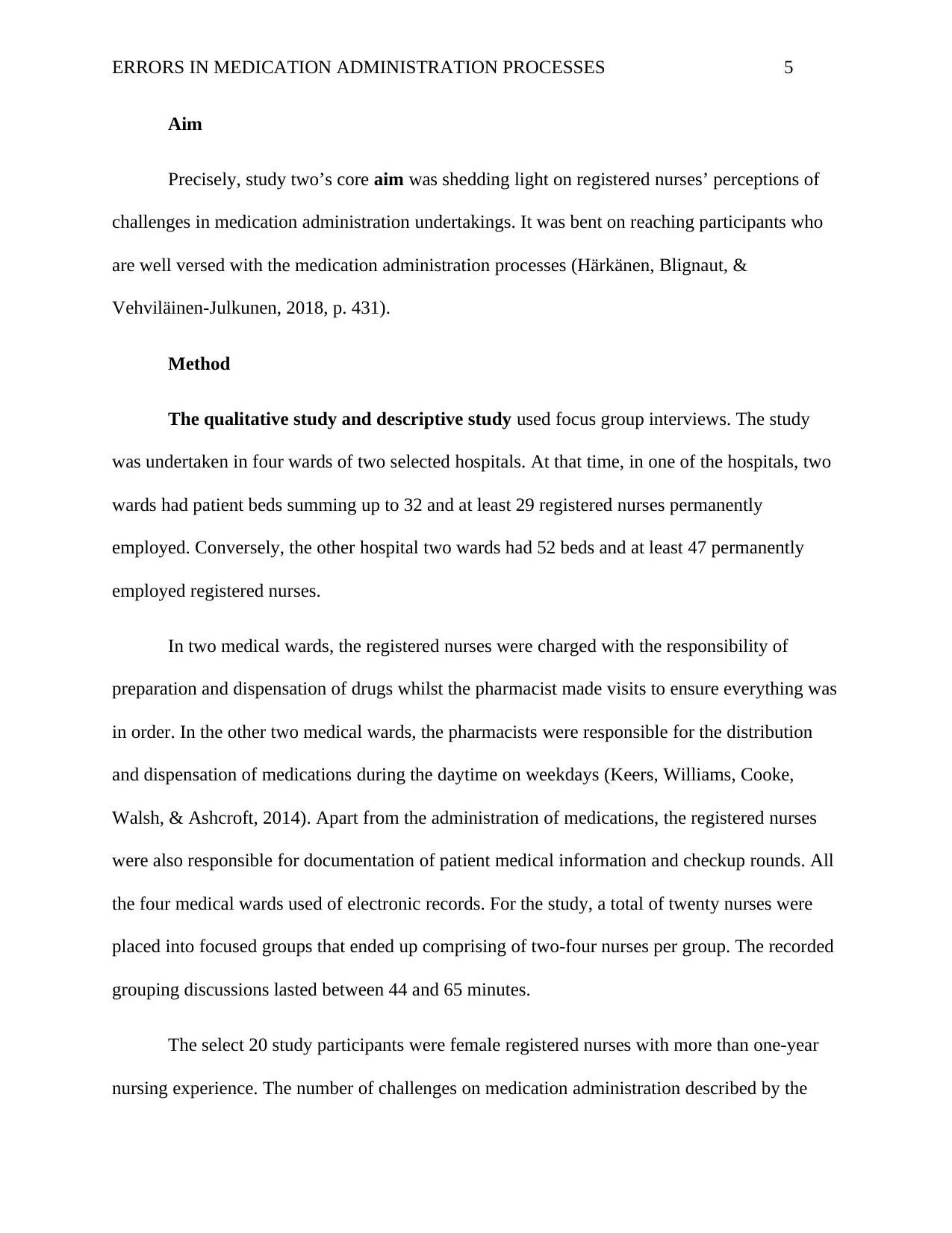
ERRORS IN MEDICATION ADMINISTRATION PROCESSES 5
Aim
Precisely, study two’s core aim was shedding light on registered nurses’ perceptions of
challenges in medication administration undertakings. It was bent on reaching participants who
are well versed with the medication administration processes (Härkänen, Blignaut, &
Vehviläinen-Julkunen, 2018, p. 431).
Method
The qualitative study and descriptive study used focus group interviews. The study
was undertaken in four wards of two selected hospitals. At that time, in one of the hospitals, two
wards had patient beds summing up to 32 and at least 29 registered nurses permanently
employed. Conversely, the other hospital two wards had 52 beds and at least 47 permanently
employed registered nurses.
In two medical wards, the registered nurses were charged with the responsibility of
preparation and dispensation of drugs whilst the pharmacist made visits to ensure everything was
in order. In the other two medical wards, the pharmacists were responsible for the distribution
and dispensation of medications during the daytime on weekdays (Keers, Williams, Cooke,
Walsh, & Ashcroft, 2014). Apart from the administration of medications, the registered nurses
were also responsible for documentation of patient medical information and checkup rounds. All
the four medical wards used of electronic records. For the study, a total of twenty nurses were
placed into focused groups that ended up comprising of two-four nurses per group. The recorded
grouping discussions lasted between 44 and 65 minutes.
The select 20 study participants were female registered nurses with more than one-year
nursing experience. The number of challenges on medication administration described by the
Aim
Precisely, study two’s core aim was shedding light on registered nurses’ perceptions of
challenges in medication administration undertakings. It was bent on reaching participants who
are well versed with the medication administration processes (Härkänen, Blignaut, &
Vehviläinen-Julkunen, 2018, p. 431).
Method
The qualitative study and descriptive study used focus group interviews. The study
was undertaken in four wards of two selected hospitals. At that time, in one of the hospitals, two
wards had patient beds summing up to 32 and at least 29 registered nurses permanently
employed. Conversely, the other hospital two wards had 52 beds and at least 47 permanently
employed registered nurses.
In two medical wards, the registered nurses were charged with the responsibility of
preparation and dispensation of drugs whilst the pharmacist made visits to ensure everything was
in order. In the other two medical wards, the pharmacists were responsible for the distribution
and dispensation of medications during the daytime on weekdays (Keers, Williams, Cooke,
Walsh, & Ashcroft, 2014). Apart from the administration of medications, the registered nurses
were also responsible for documentation of patient medical information and checkup rounds. All
the four medical wards used of electronic records. For the study, a total of twenty nurses were
placed into focused groups that ended up comprising of two-four nurses per group. The recorded
grouping discussions lasted between 44 and 65 minutes.
The select 20 study participants were female registered nurses with more than one-year
nursing experience. The number of challenges on medication administration described by the
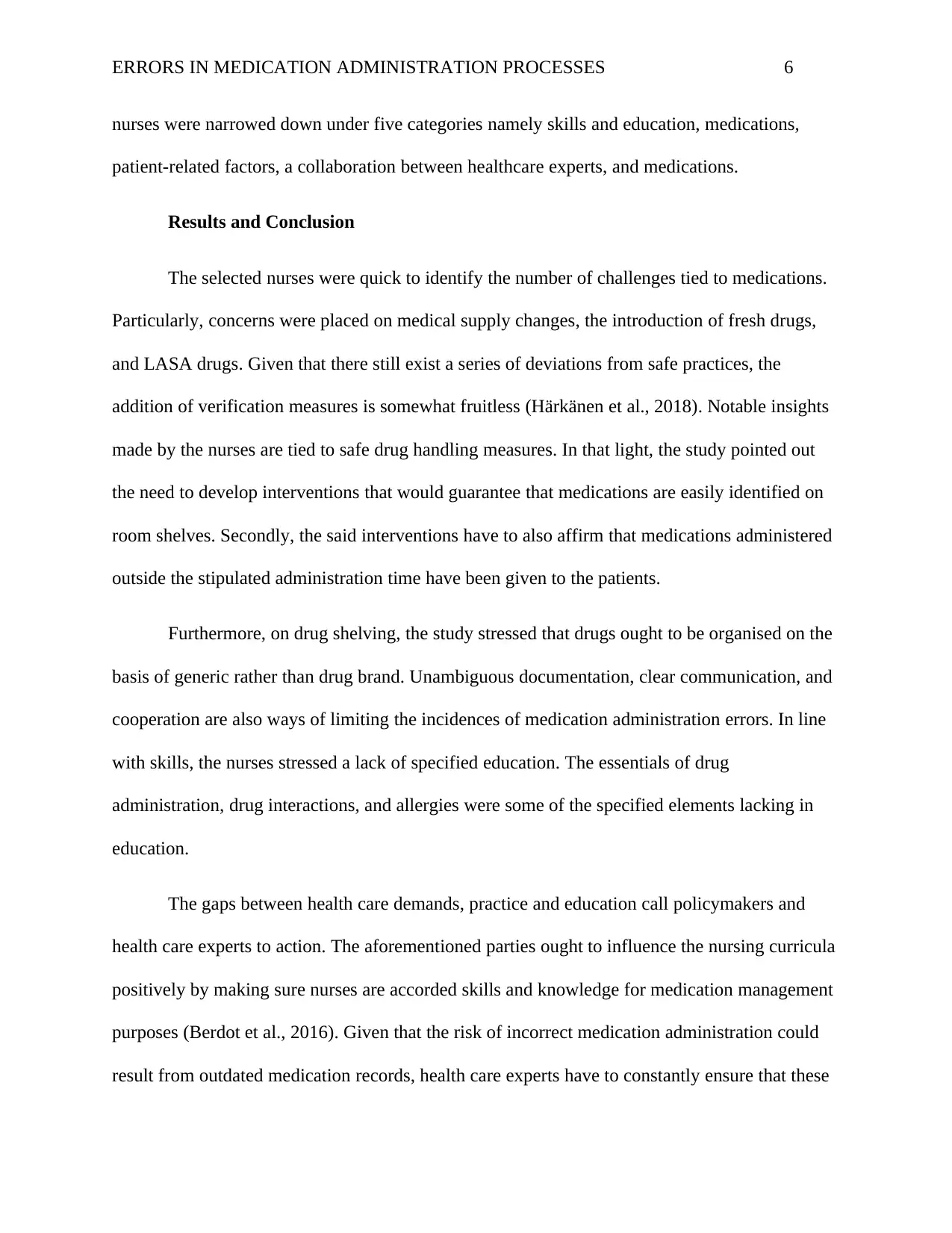
ERRORS IN MEDICATION ADMINISTRATION PROCESSES 6
nurses were narrowed down under five categories namely skills and education, medications,
patient-related factors, a collaboration between healthcare experts, and medications.
Results and Conclusion
The selected nurses were quick to identify the number of challenges tied to medications.
Particularly, concerns were placed on medical supply changes, the introduction of fresh drugs,
and LASA drugs. Given that there still exist a series of deviations from safe practices, the
addition of verification measures is somewhat fruitless (Härkänen et al., 2018). Notable insights
made by the nurses are tied to safe drug handling measures. In that light, the study pointed out
the need to develop interventions that would guarantee that medications are easily identified on
room shelves. Secondly, the said interventions have to also affirm that medications administered
outside the stipulated administration time have been given to the patients.
Furthermore, on drug shelving, the study stressed that drugs ought to be organised on the
basis of generic rather than drug brand. Unambiguous documentation, clear communication, and
cooperation are also ways of limiting the incidences of medication administration errors. In line
with skills, the nurses stressed a lack of specified education. The essentials of drug
administration, drug interactions, and allergies were some of the specified elements lacking in
education.
The gaps between health care demands, practice and education call policymakers and
health care experts to action. The aforementioned parties ought to influence the nursing curricula
positively by making sure nurses are accorded skills and knowledge for medication management
purposes (Berdot et al., 2016). Given that the risk of incorrect medication administration could
result from outdated medication records, health care experts have to constantly ensure that these
nurses were narrowed down under five categories namely skills and education, medications,
patient-related factors, a collaboration between healthcare experts, and medications.
Results and Conclusion
The selected nurses were quick to identify the number of challenges tied to medications.
Particularly, concerns were placed on medical supply changes, the introduction of fresh drugs,
and LASA drugs. Given that there still exist a series of deviations from safe practices, the
addition of verification measures is somewhat fruitless (Härkänen et al., 2018). Notable insights
made by the nurses are tied to safe drug handling measures. In that light, the study pointed out
the need to develop interventions that would guarantee that medications are easily identified on
room shelves. Secondly, the said interventions have to also affirm that medications administered
outside the stipulated administration time have been given to the patients.
Furthermore, on drug shelving, the study stressed that drugs ought to be organised on the
basis of generic rather than drug brand. Unambiguous documentation, clear communication, and
cooperation are also ways of limiting the incidences of medication administration errors. In line
with skills, the nurses stressed a lack of specified education. The essentials of drug
administration, drug interactions, and allergies were some of the specified elements lacking in
education.
The gaps between health care demands, practice and education call policymakers and
health care experts to action. The aforementioned parties ought to influence the nursing curricula
positively by making sure nurses are accorded skills and knowledge for medication management
purposes (Berdot et al., 2016). Given that the risk of incorrect medication administration could
result from outdated medication records, health care experts have to constantly ensure that these
⊘ This is a preview!⊘
Do you want full access?
Subscribe today to unlock all pages.

Trusted by 1+ million students worldwide
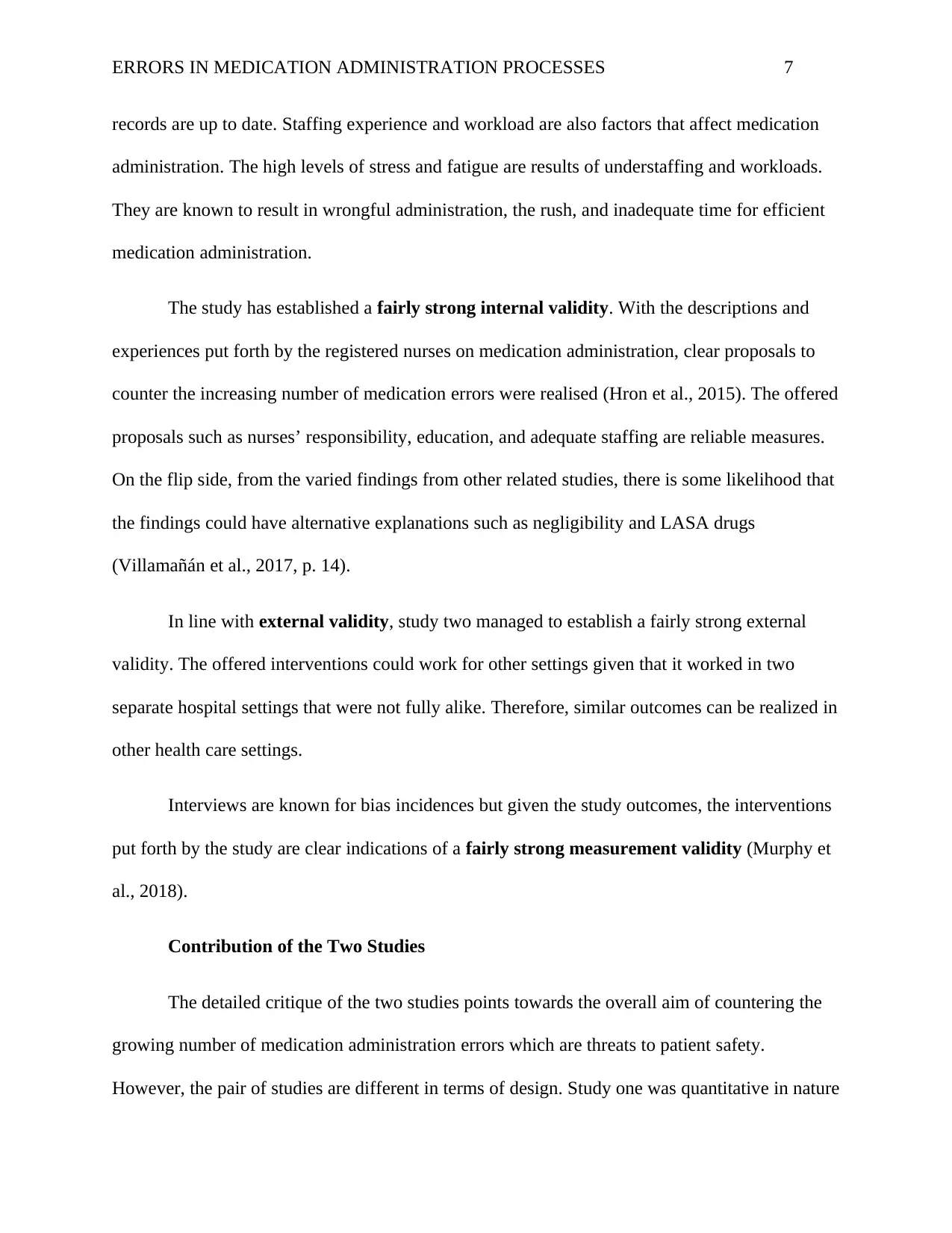
ERRORS IN MEDICATION ADMINISTRATION PROCESSES 7
records are up to date. Staffing experience and workload are also factors that affect medication
administration. The high levels of stress and fatigue are results of understaffing and workloads.
They are known to result in wrongful administration, the rush, and inadequate time for efficient
medication administration.
The study has established a fairly strong internal validity. With the descriptions and
experiences put forth by the registered nurses on medication administration, clear proposals to
counter the increasing number of medication errors were realised (Hron et al., 2015). The offered
proposals such as nurses’ responsibility, education, and adequate staffing are reliable measures.
On the flip side, from the varied findings from other related studies, there is some likelihood that
the findings could have alternative explanations such as negligibility and LASA drugs
(Villamañán et al., 2017, p. 14).
In line with external validity, study two managed to establish a fairly strong external
validity. The offered interventions could work for other settings given that it worked in two
separate hospital settings that were not fully alike. Therefore, similar outcomes can be realized in
other health care settings.
Interviews are known for bias incidences but given the study outcomes, the interventions
put forth by the study are clear indications of a fairly strong measurement validity (Murphy et
al., 2018).
Contribution of the Two Studies
The detailed critique of the two studies points towards the overall aim of countering the
growing number of medication administration errors which are threats to patient safety.
However, the pair of studies are different in terms of design. Study one was quantitative in nature
records are up to date. Staffing experience and workload are also factors that affect medication
administration. The high levels of stress and fatigue are results of understaffing and workloads.
They are known to result in wrongful administration, the rush, and inadequate time for efficient
medication administration.
The study has established a fairly strong internal validity. With the descriptions and
experiences put forth by the registered nurses on medication administration, clear proposals to
counter the increasing number of medication errors were realised (Hron et al., 2015). The offered
proposals such as nurses’ responsibility, education, and adequate staffing are reliable measures.
On the flip side, from the varied findings from other related studies, there is some likelihood that
the findings could have alternative explanations such as negligibility and LASA drugs
(Villamañán et al., 2017, p. 14).
In line with external validity, study two managed to establish a fairly strong external
validity. The offered interventions could work for other settings given that it worked in two
separate hospital settings that were not fully alike. Therefore, similar outcomes can be realized in
other health care settings.
Interviews are known for bias incidences but given the study outcomes, the interventions
put forth by the study are clear indications of a fairly strong measurement validity (Murphy et
al., 2018).
Contribution of the Two Studies
The detailed critique of the two studies points towards the overall aim of countering the
growing number of medication administration errors which are threats to patient safety.
However, the pair of studies are different in terms of design. Study one was quantitative in nature
Paraphrase This Document
Need a fresh take? Get an instant paraphrase of this document with our AI Paraphraser
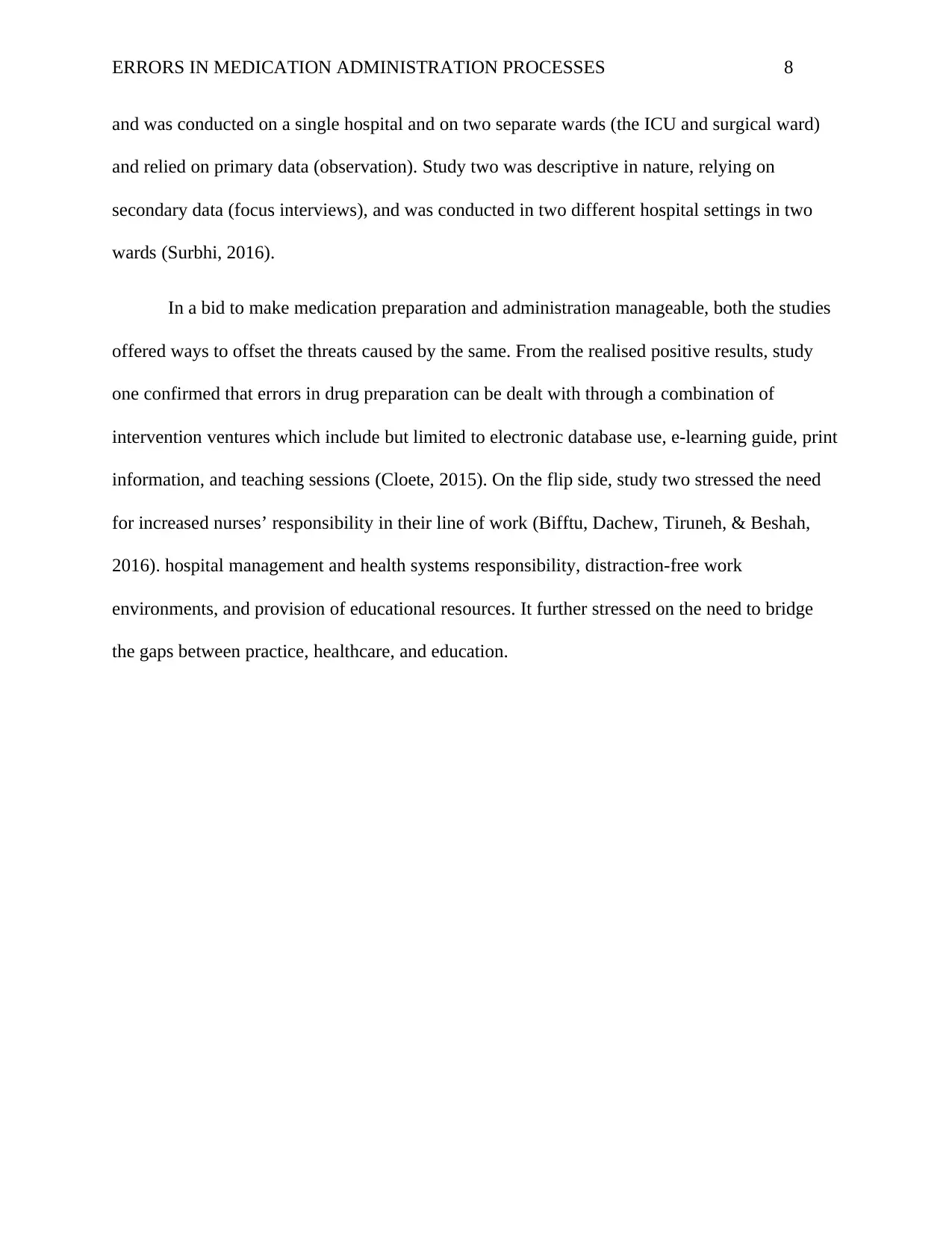
ERRORS IN MEDICATION ADMINISTRATION PROCESSES 8
and was conducted on a single hospital and on two separate wards (the ICU and surgical ward)
and relied on primary data (observation). Study two was descriptive in nature, relying on
secondary data (focus interviews), and was conducted in two different hospital settings in two
wards (Surbhi, 2016).
In a bid to make medication preparation and administration manageable, both the studies
offered ways to offset the threats caused by the same. From the realised positive results, study
one confirmed that errors in drug preparation can be dealt with through a combination of
intervention ventures which include but limited to electronic database use, e-learning guide, print
information, and teaching sessions (Cloete, 2015). On the flip side, study two stressed the need
for increased nurses’ responsibility in their line of work (Bifftu, Dachew, Tiruneh, & Beshah,
2016). hospital management and health systems responsibility, distraction-free work
environments, and provision of educational resources. It further stressed on the need to bridge
the gaps between practice, healthcare, and education.
and was conducted on a single hospital and on two separate wards (the ICU and surgical ward)
and relied on primary data (observation). Study two was descriptive in nature, relying on
secondary data (focus interviews), and was conducted in two different hospital settings in two
wards (Surbhi, 2016).
In a bid to make medication preparation and administration manageable, both the studies
offered ways to offset the threats caused by the same. From the realised positive results, study
one confirmed that errors in drug preparation can be dealt with through a combination of
intervention ventures which include but limited to electronic database use, e-learning guide, print
information, and teaching sessions (Cloete, 2015). On the flip side, study two stressed the need
for increased nurses’ responsibility in their line of work (Bifftu, Dachew, Tiruneh, & Beshah,
2016). hospital management and health systems responsibility, distraction-free work
environments, and provision of educational resources. It further stressed on the need to bridge
the gaps between practice, healthcare, and education.
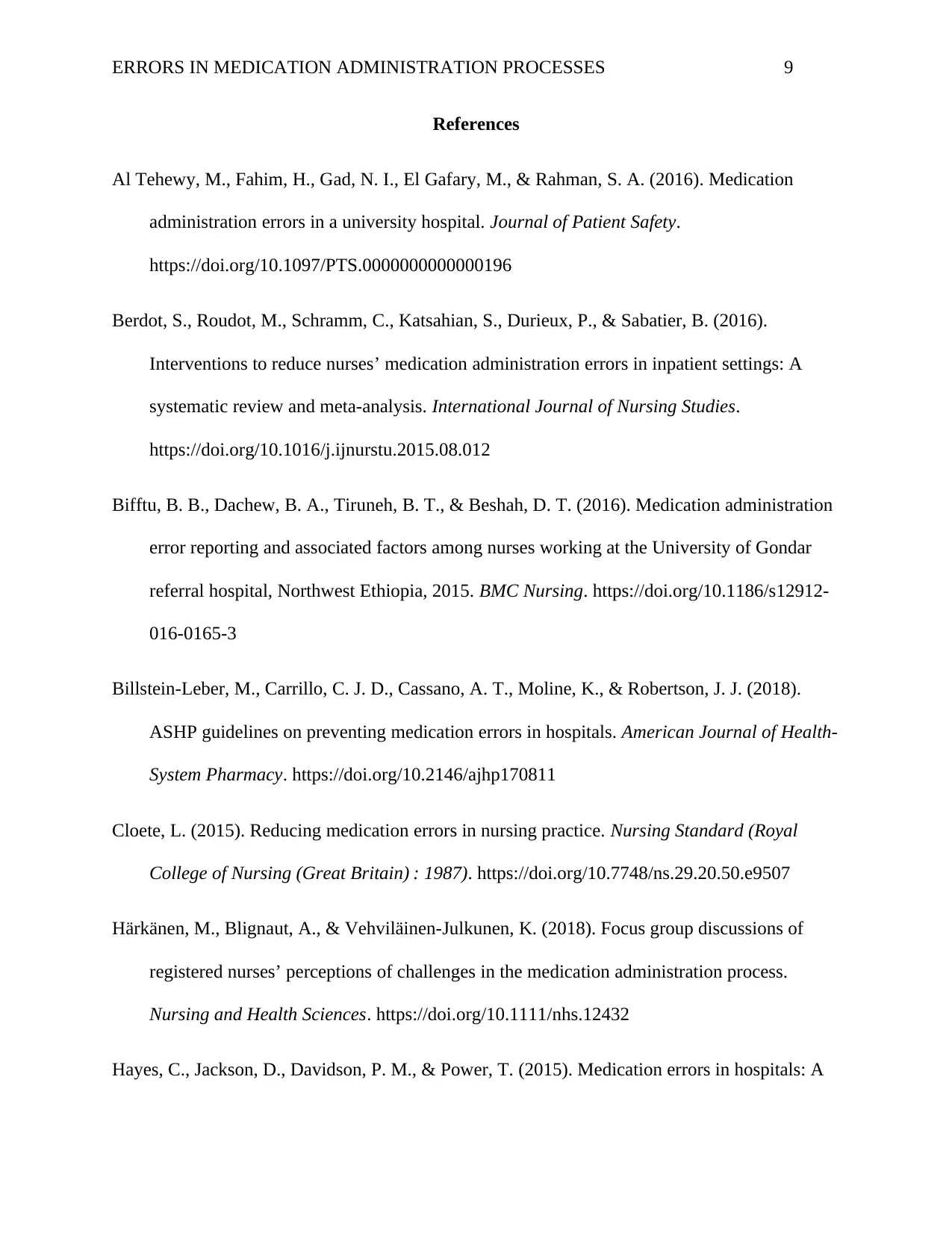
ERRORS IN MEDICATION ADMINISTRATION PROCESSES 9
References
Al Tehewy, M., Fahim, H., Gad, N. I., El Gafary, M., & Rahman, S. A. (2016). Medication
administration errors in a university hospital. Journal of Patient Safety.
https://doi.org/10.1097/PTS.0000000000000196
Berdot, S., Roudot, M., Schramm, C., Katsahian, S., Durieux, P., & Sabatier, B. (2016).
Interventions to reduce nurses’ medication administration errors in inpatient settings: A
systematic review and meta-analysis. International Journal of Nursing Studies.
https://doi.org/10.1016/j.ijnurstu.2015.08.012
Bifftu, B. B., Dachew, B. A., Tiruneh, B. T., & Beshah, D. T. (2016). Medication administration
error reporting and associated factors among nurses working at the University of Gondar
referral hospital, Northwest Ethiopia, 2015. BMC Nursing. https://doi.org/10.1186/s12912-
016-0165-3
Billstein-Leber, M., Carrillo, C. J. D., Cassano, A. T., Moline, K., & Robertson, J. J. (2018).
ASHP guidelines on preventing medication errors in hospitals. American Journal of Health-
System Pharmacy. https://doi.org/10.2146/ajhp170811
Cloete, L. (2015). Reducing medication errors in nursing practice. Nursing Standard (Royal
College of Nursing (Great Britain) : 1987). https://doi.org/10.7748/ns.29.20.50.e9507
Härkänen, M., Blignaut, A., & Vehviläinen-Julkunen, K. (2018). Focus group discussions of
registered nurses’ perceptions of challenges in the medication administration process.
Nursing and Health Sciences. https://doi.org/10.1111/nhs.12432
Hayes, C., Jackson, D., Davidson, P. M., & Power, T. (2015). Medication errors in hospitals: A
References
Al Tehewy, M., Fahim, H., Gad, N. I., El Gafary, M., & Rahman, S. A. (2016). Medication
administration errors in a university hospital. Journal of Patient Safety.
https://doi.org/10.1097/PTS.0000000000000196
Berdot, S., Roudot, M., Schramm, C., Katsahian, S., Durieux, P., & Sabatier, B. (2016).
Interventions to reduce nurses’ medication administration errors in inpatient settings: A
systematic review and meta-analysis. International Journal of Nursing Studies.
https://doi.org/10.1016/j.ijnurstu.2015.08.012
Bifftu, B. B., Dachew, B. A., Tiruneh, B. T., & Beshah, D. T. (2016). Medication administration
error reporting and associated factors among nurses working at the University of Gondar
referral hospital, Northwest Ethiopia, 2015. BMC Nursing. https://doi.org/10.1186/s12912-
016-0165-3
Billstein-Leber, M., Carrillo, C. J. D., Cassano, A. T., Moline, K., & Robertson, J. J. (2018).
ASHP guidelines on preventing medication errors in hospitals. American Journal of Health-
System Pharmacy. https://doi.org/10.2146/ajhp170811
Cloete, L. (2015). Reducing medication errors in nursing practice. Nursing Standard (Royal
College of Nursing (Great Britain) : 1987). https://doi.org/10.7748/ns.29.20.50.e9507
Härkänen, M., Blignaut, A., & Vehviläinen-Julkunen, K. (2018). Focus group discussions of
registered nurses’ perceptions of challenges in the medication administration process.
Nursing and Health Sciences. https://doi.org/10.1111/nhs.12432
Hayes, C., Jackson, D., Davidson, P. M., & Power, T. (2015). Medication errors in hospitals: A
⊘ This is a preview!⊘
Do you want full access?
Subscribe today to unlock all pages.

Trusted by 1+ million students worldwide
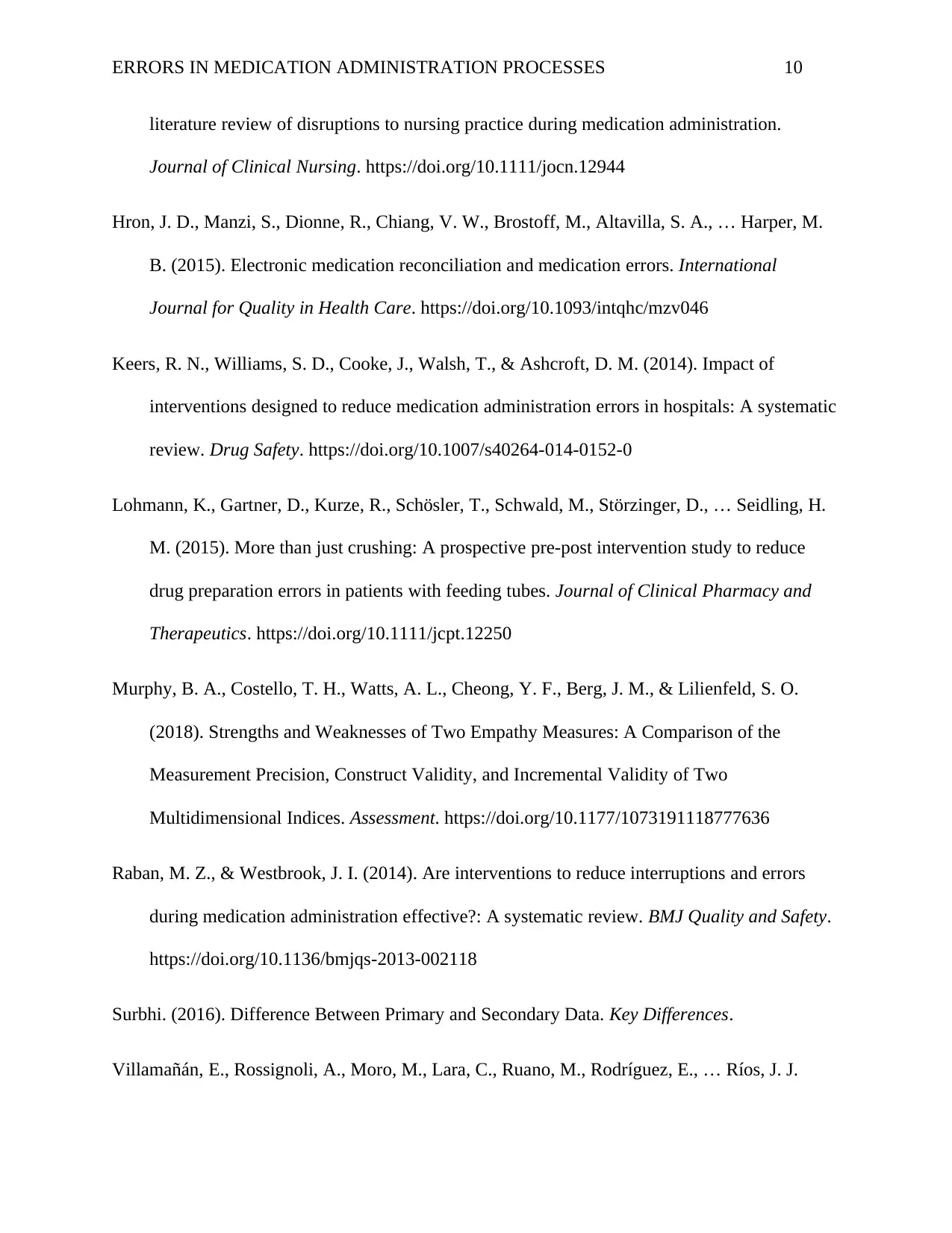
ERRORS IN MEDICATION ADMINISTRATION PROCESSES 10
literature review of disruptions to nursing practice during medication administration.
Journal of Clinical Nursing. https://doi.org/10.1111/jocn.12944
Hron, J. D., Manzi, S., Dionne, R., Chiang, V. W., Brostoff, M., Altavilla, S. A., … Harper, M.
B. (2015). Electronic medication reconciliation and medication errors. International
Journal for Quality in Health Care. https://doi.org/10.1093/intqhc/mzv046
Keers, R. N., Williams, S. D., Cooke, J., Walsh, T., & Ashcroft, D. M. (2014). Impact of
interventions designed to reduce medication administration errors in hospitals: A systematic
review. Drug Safety. https://doi.org/10.1007/s40264-014-0152-0
Lohmann, K., Gartner, D., Kurze, R., Schösler, T., Schwald, M., Störzinger, D., … Seidling, H.
M. (2015). More than just crushing: A prospective pre-post intervention study to reduce
drug preparation errors in patients with feeding tubes. Journal of Clinical Pharmacy and
Therapeutics. https://doi.org/10.1111/jcpt.12250
Murphy, B. A., Costello, T. H., Watts, A. L., Cheong, Y. F., Berg, J. M., & Lilienfeld, S. O.
(2018). Strengths and Weaknesses of Two Empathy Measures: A Comparison of the
Measurement Precision, Construct Validity, and Incremental Validity of Two
Multidimensional Indices. Assessment. https://doi.org/10.1177/1073191118777636
Raban, M. Z., & Westbrook, J. I. (2014). Are interventions to reduce interruptions and errors
during medication administration effective?: A systematic review. BMJ Quality and Safety.
https://doi.org/10.1136/bmjqs-2013-002118
Surbhi. (2016). Difference Between Primary and Secondary Data. Key Differences.
Villamañán, E., Rossignoli, A., Moro, M., Lara, C., Ruano, M., Rodríguez, E., … Ríos, J. J.
literature review of disruptions to nursing practice during medication administration.
Journal of Clinical Nursing. https://doi.org/10.1111/jocn.12944
Hron, J. D., Manzi, S., Dionne, R., Chiang, V. W., Brostoff, M., Altavilla, S. A., … Harper, M.
B. (2015). Electronic medication reconciliation and medication errors. International
Journal for Quality in Health Care. https://doi.org/10.1093/intqhc/mzv046
Keers, R. N., Williams, S. D., Cooke, J., Walsh, T., & Ashcroft, D. M. (2014). Impact of
interventions designed to reduce medication administration errors in hospitals: A systematic
review. Drug Safety. https://doi.org/10.1007/s40264-014-0152-0
Lohmann, K., Gartner, D., Kurze, R., Schösler, T., Schwald, M., Störzinger, D., … Seidling, H.
M. (2015). More than just crushing: A prospective pre-post intervention study to reduce
drug preparation errors in patients with feeding tubes. Journal of Clinical Pharmacy and
Therapeutics. https://doi.org/10.1111/jcpt.12250
Murphy, B. A., Costello, T. H., Watts, A. L., Cheong, Y. F., Berg, J. M., & Lilienfeld, S. O.
(2018). Strengths and Weaknesses of Two Empathy Measures: A Comparison of the
Measurement Precision, Construct Validity, and Incremental Validity of Two
Multidimensional Indices. Assessment. https://doi.org/10.1177/1073191118777636
Raban, M. Z., & Westbrook, J. I. (2014). Are interventions to reduce interruptions and errors
during medication administration effective?: A systematic review. BMJ Quality and Safety.
https://doi.org/10.1136/bmjqs-2013-002118
Surbhi. (2016). Difference Between Primary and Secondary Data. Key Differences.
Villamañán, E., Rossignoli, A., Moro, M., Lara, C., Ruano, M., Rodríguez, E., … Ríos, J. J.
Paraphrase This Document
Need a fresh take? Get an instant paraphrase of this document with our AI Paraphraser
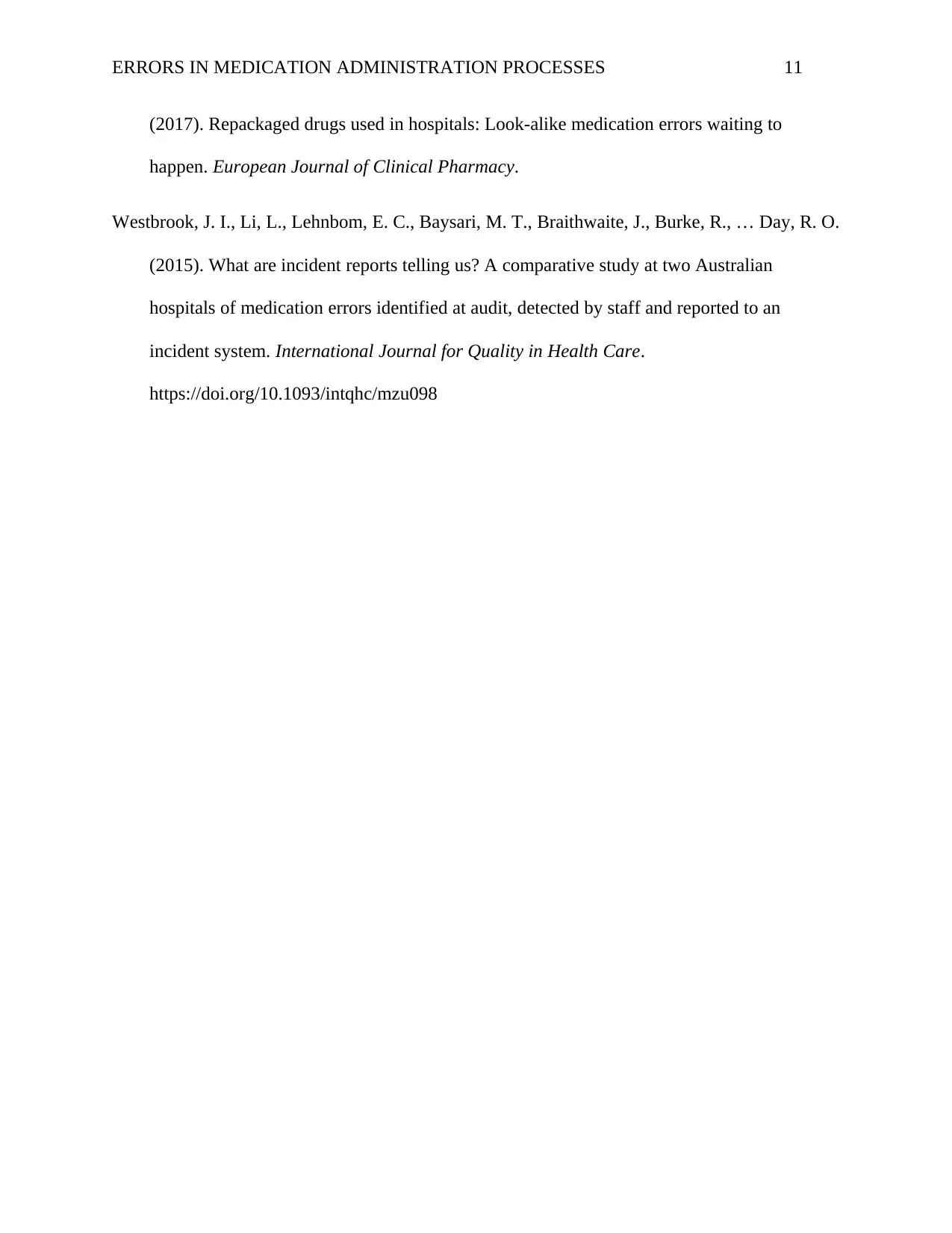
ERRORS IN MEDICATION ADMINISTRATION PROCESSES 11
(2017). Repackaged drugs used in hospitals: Look-alike medication errors waiting to
happen. European Journal of Clinical Pharmacy.
Westbrook, J. I., Li, L., Lehnbom, E. C., Baysari, M. T., Braithwaite, J., Burke, R., … Day, R. O.
(2015). What are incident reports telling us? A comparative study at two Australian
hospitals of medication errors identified at audit, detected by staff and reported to an
incident system. International Journal for Quality in Health Care.
https://doi.org/10.1093/intqhc/mzu098
(2017). Repackaged drugs used in hospitals: Look-alike medication errors waiting to
happen. European Journal of Clinical Pharmacy.
Westbrook, J. I., Li, L., Lehnbom, E. C., Baysari, M. T., Braithwaite, J., Burke, R., … Day, R. O.
(2015). What are incident reports telling us? A comparative study at two Australian
hospitals of medication errors identified at audit, detected by staff and reported to an
incident system. International Journal for Quality in Health Care.
https://doi.org/10.1093/intqhc/mzu098
1 out of 11
Related Documents
Your All-in-One AI-Powered Toolkit for Academic Success.
+13062052269
info@desklib.com
Available 24*7 on WhatsApp / Email
![[object Object]](/_next/static/media/star-bottom.7253800d.svg)
Unlock your academic potential
Copyright © 2020–2025 A2Z Services. All Rights Reserved. Developed and managed by ZUCOL.





